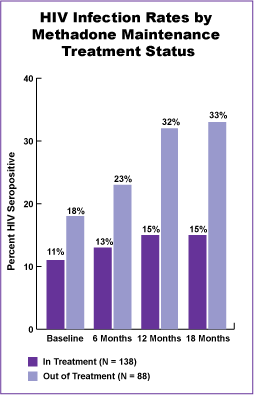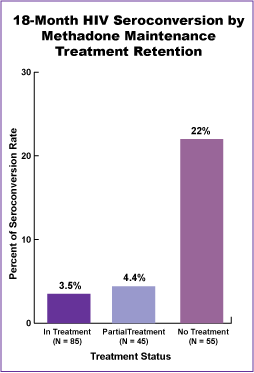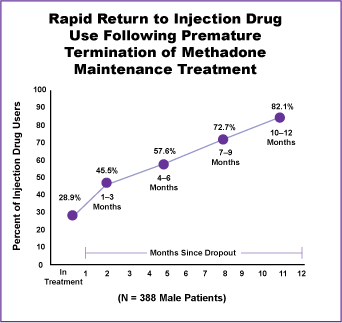Question 3: Does methadone maintenance treatment reduce HIV risk behaviors and the incidence of HIV infection among opioid-dependent injection drug users?
Answer: Yes. The daily oral administration of adequate dosages of methadone reduces the need for opioid-dependent individuals to inject drugs. By decreasing injection drug use, methadone maintenance treatment helps reduce the spread of diseases transmitted through needle sharing, such as human immunodeficiency virus (HIV) infection, hepatitis C virus (HCV), and other bloodborne infections (Sullivan, Metzger, Fudala, et al., 2005; Gowing, Farrell, Bornemann, et al., in press).
Research Highlights
A systematic review of 23 studies of 7,900 patients in diverse countries and settings reported significant decreases in the following HIV risk behaviors among patients receiving methadone maintenance treatment: (1) the proportion of opioid-dependent injection drugs, (2) the reported frequency of injection, (3) levels of sharing of injection equipment, (4) illicit opioid use, (5) reduction in the proportion of opioid-dependent injection drug users reporting multiple sex partners or exchanges of sex for drugs or money, and (6) reductions in cases of HIV infection among opioid-dependent injection drug users. However, it should be noted that methadone treatment had little or no effect on the use of condoms. The authors concluded that the provision of agonist treatment for opioid dependence should be supported in countries with emerging HIV and injection drug use problems as well as in countries with established populations of injection drug users (Gowing, Farrell, Bornemann, et al., 2004).
These results support an earlier meta-analysis of 11 studies that found a consistent, statistically significant relationship between methadone maintenance treatment and the reduction of HIV risk behaviors. This meta-analysis found that methadone maintenance treatment had a small-to-moderate effect in reducing HIV risk behaviors (Marsch, 1998).
- A study that evaluated HIV risk behavior in patients receiving ongoing methadone maintenance compared with patients receiving 6 months of methadone maintenance followed by detoxification demonstrated that those patients who received ongoing methadone maintenance treatment reported lower HIV drug (but not sex) risk behaviors after 6 and 12 months of treatment (Sees, Delucchi, Masson, et al., 2000).
- In New Haven, CT, 107 methadone-maintained injection drug users who were not in treatment were surveyed regarding their risk behaviors. The frequency of injections was found to be 50 to 65 percent (p < .001) higher among the out-of-treatment subjects (Meandzija, O'Connor, Fitzgerald, et al., 1994).
- In a 3-year field study of methadone maintenance treatment programs in New York, NY, Philadelphia, PA, and Baltimore, MD, treatment was found to be effective in reducing injection drug use and needle sharing by most heroin addicts. Of 388 patients who remained in treatment for 1 year or more, 71 percent had stopped injection drug use. Conversely, 82 percent of patients who left treatment relapsed rapidly to injection drug use (Ball, Lang, Meyers, et al., 1988).
- Abdul-Quader, Friedman, Des Jarlais, et al. (1987) reported that both the frequency of drug injection and the frequency of drug injection in shooting galleries were significantly reduced by the amount of time spent in methadone maintenance treatment.
- A study by Serpelloni, Carrieri, Rezza, et al. (1994) examined the effect of methadone maintenance treatment on HIV infection incidence among injection drug users. The study found that the amount of time spent in methadone maintenance treatment was the major determinant in remaining HIV-free, which confirms the effectiveness of long-term programs in reducing the risk of HIV infection. Indeed, the risk of HIV infection increased 1.5 times for every 3 months spent out of methadone treatment in the past 12 months immediately preceding seroconversion. The study noted that higher daily methadone doses were associated with a reduction in HIV infection.
- A study by Weber, Ledergerber, Opravil, et al. (1990) examined the role of methadone maintenance treatment in reducing the progression of HIV infection among 297 current and former injection drug users with asymptomatic HIV infection. The study showed that HIV infection progresses significantly more slowly in those who receive methadone maintenance treatment and those who are drug free than in active injection drug users.
- In Philadelphia, PA, a longitudinal study of HIV infection and risk behaviors among 152 injection drug users in methadone maintenance treatment and 103 out-of-treatment injection drug users found significantly lower rates of risk behavior, including needle sharing, injection frequency, shooting gallery use, and visits to crack houses among the methadone-maintained users. While 70 percent of the out-of-treatment cohort reported sharing needles during the 6 months before entry into the study, only 30 percent of those in treatment reported sharing needles during this same interval.
- At entry into this study, 18 percent of the out-of-treatment subjects and 11 percent of the methadone-maintained clients tested positive for antibodies to HIV. After 18 months of study, 33 percent of the out-of-treatment cohort were infected, whereas 15 percent of the methadone clients tested positive (p < 0.01). The incidence of new infection was strongly associated with the level of participation in methadone treatment. Among those who remained in methadone treatment for the entire 18-month study period, 3.5 percent became infected. Among those who remained out of treatment, 22 percent became infected with HIV (Metzger, Woody, McLellan, et al., 1993).
- Another study of HIV seroconversion followed 56 patients who were continuously enrolled in methadone maintenance and compared them with 42 patients who had intermittent methadone treatment. Subjects in continuous treatment had a seroconversion rate of 0.7 per 100 person years (95% CI = 0.1, 5.3), and those with interrupted treatment had a rate of 4.3 per 100 person years (95% CI = 2.2, 8.6) (Williams, McNelly, Williams, et al., 1992).
- A relatively short-term study of methadone maintenance versus control in a prison system in Australia found reductions in opioid use but no changes in HIV or HCV incidence (Dolan, Shearer, MacDonald, 2003).
The following two visuals–HIV Infection Rates by Methadone Maintenance Treatment Status and 18-Month HIV Seroconversion by Methadone Maintenance Treatment Retention–depict findings from this study.

Figure 14 illustrates that at the beginning of this study, 18 percent of the out-of-treatment subjects and 11 percent of the methadone-maintained clients tested positive for antibodies to HIV. After 18 months, nearly twice as many (33 percent) of the out-of-treatment cohort were HIV-positive, whereas only 15 percent of the methadone clients tested positive (p < .01). The incidence of new infection was strongly associated with the level of participation in methadone treatment.

Figure 15 illustrates that among those who remained in methadone maintenance treatment for the entire 18-month study period, 3.5 percent became infected with HIV. Among those who remained out of treatment, 22 percent became infected with HIV (Metzger et al., 1993).
Rapid Return to Injection Drug Use Following Premature Termination of Methadone Maintenance Treatment–In a 3-year field study of methadone maintenance treatment programs in New York, NY, Philadelphia, PA, and Baltimore, MD, methadone maintenance treatment was found to be effective in reducing injection drug use and needle sharing by most heroin addicts. Of 388 patients who remained in treatment for 1 year or more, 71 percent had stopped injection drug use. Conversely, 82 percent of the 105 patients who left treatment relapsed rapidly to injection drug use (Ball et al., 1988).

Figure 16 illustrates that methadone maintenance treatment is associated with reductions in injection drug use and the risks related to HIV infection. When drug users leave methadone maintenance treatment prematurely, they have an increased likelihood of returning to injection drug use (Ball et al., 1988).
References
Abdul-Quader OS, Friedman SR, Des Jarlais DC, Marmor MM, Maslansky R, Bartelme S. Methadone maintenance and behavior by intravenous drug users that can transmit HIV. Contemporary Drug Problems 1987;14:425-33.
Ball JC, Lange WR, Meyers CP, Friedman SR. Reducing the risk of AIDS through methadone maintenance treatment. Journal of Health and Social Behavior 1988;29:214-226.
Dolan KA, Shearer J, MacDonald M, Mattick RP, Hall W, Wodak AD. A randomized controlled trial of methadone maintenance treatment versus wait list control in an Australian prison system. Drug & Alcohol Dependence2003;72(1):59-65.
Gowing L, Farrell M, Bornemann R, Ali R. Substitution treatment of injecting opioid users for prevention of HIV infection. The Cochrane Database of Systematic Reviews, Issue 4, 2004.
Gowing LR, Farrell M, Bornemann R, Sullivan L, Ali, R. Methadone treatment of injecting opioid users for prevention of HIV infection. Journal of General Internal Medicine, in press.
Marsch LA. The efficacy of methadone maintenance interventions in reducing illicit opiate use, HIV risk behavior and criminality: a meta-analysis. Addiction 1998;93(4):515-32.
Meandzija B, O'Connor PG, Fitzgerald B, Rounsaville BJ, Kosten TR. HIV infection and cocaine use in methadone maintained and untreated intravenous drug users. Drug & Alcohol Dependence 1994;36(2):109-13.
Metzger DS, Woody GE, McLellan AT, O'Brien CP, Druley P, Navaline H, et al. Human immunodeficiency virus seroconversion among intravenous drug users in- and out-of-treatment: an 18-month prospective follow-up. Journal of Acquired Immune Deficiency Syndrome 1993;6:1049-56.
Sees KL, Delucchi KL, Masson C, Rosen A, Clark HW, Robillard H, et al. Methadone maintenance vs 180-day psychosocially enriched detoxification for treatment of opioid dependence. A randomized controlled trial. JAMA2000;283:1303-10.
Serpelloni G, Carrieri MP, Rezza G, Morganti S, Gomma M, Binkin N. Methadone treatment as a determinant of HIV risk reduction among injecting drug users: a nested case-control study. AIDS Care 1994;6:215-20.
Sullivan LE, Metzger DS, Fudala PJ, Fiellin DA. Decreasing international HIV transmission: the role of expanding access to opioid agonist therapies for injection drug users. Addiction 2005;100(2):150-58.
Weber RB, Ledergerber M, Opravil M, Siegenthaler W, Luthy R. Progression of HIV infection in misuers of injected drugs who stop injecting or follow a programme of maintenance treatment with methadone. British Medical Journal1990;301:1362-5.
Williams AB, McNelly EA, Williams AE, D'Aquila RT. Methadone maintenance treatment and HIV type 1 seroconversion among injecting drug users. AIDS Care 1992;4(1):35-41
In This Section
- Certificate Programs
- Methadone Research Web Guide
- Acknowledgments
- Introduction
- Part A
- Part B
- Question 1: Is methadone maintenance treatment effective for opioid addiction?
- Question 2: Does methadone maintenance treatment reduce illicit opioid use?
- Question 3: Does methadone maintenance treatment reduce HIV risk behaviors and the incidence of HIV infection among opioid-depen
- Question 4: Does methadone maintenance treatment reduce criminal activity?
- Question 5: Does methadone maintenance treatment improve the likelihood of obtaining and retaining employment?
- Question 6: What effect can methadone maintenance treatment have on the use of alcohol and other drugs?
- Question 7: What components of methadone maintenance treatment account for reductions in AIDS risk behaviors?
- Question 8: Do risk factors for HIV infection acquisition and transmission differ for women compared with men in methadone maint
- Question 9: Is methadone maintenance treatment effective for women?
- Question 10: Is methadone safe for pregnant women and their infants?
- Question 11: Is it necessary to reduce methadone dose or detoxify women from methadone during pregnancy to protect the f
- Question 12: Is the long-term use of methadone medically safe, and is it well tolerated by patients?
- Question 13: Are there program characteristics associated with the success of methadone maintenance treatment?
- Question 14: Are there patient characteristics associated with the success of methadone maintenance treatment?
- Question 15: Are there cost benefits to methadone maintenance treatment?
- Question 16: What are the retention rates for methadone maintenance treatment?
- Question 17: Is mandated methadone maintenance treatment as effective as voluntary treatment?
- Question 18: What is the role of L-alpha-acetyl-methadol (LAAM)?
- Question 19: How do buprenorphine and methadone compare?
- Question 20: Can methadone and buprenorphine be abused?
- Part C
- Part D
- Methadone Research Web Guide Tutorial
- Questions: Methadone Research Web Guide
- Answers: Methadone Research Web Guide
- Methadone Research Web Guide
- Degree Programs
- Virtual Lectures
- Research Publications
Important Dates
NIDA International Forum
June 14–17, 2013
Online Registration Deadline:
May 6, 2013
FELLOWSHIPS
IAS/NIDA Fellowships
Application Deadline:
February 10, 2013
NIDA International Program Fellowships
Application Deadline:
April 1, 2013
Global Health Program for Fellows and Scholars
Application Deadlines: Vary
GRANTS
Brain Disorders in the Developing World: Research Across the Lifespan
(Non-AIDS)
R01 PAR-11-030and R21 PAR-11-031
Application deadline:
February 14, 2013
MEETINGS
American Association for the Advancement of Science
February 14–18, 2013
Boston, Massachusetts, USA
International Drug Abuse Research Society (IDARS)
April 15–19, 2013
Mexico City, Mexico
2013 International Conference on Global Health: Prevention and Treatment of Substance Abuse and HIV
April 17–19, 2013
Taipei, Taiwan
Yih-Ing Hser, Ph.D.

.png)


